► Watch Murray sign off his fan-assisted hypercar
► First customer cars are already under construction
► Prices start from £2.4m, rise to £3.1m for T.50s
After months of preparation, Gordon Murray Automotive has finally signed off its fan-assisted T.50 hypercar. Gordon Murray himself and the legendary motorsport commentator and touring car racer, Dario Franchitti, conducted the final test drive. You can watch their reactions to the car in the video below.
It’s the latest video in Gordon Murray Automotive’s behind-the-scenes documentary of the T.50’s development programme, which has followed the hypercar from its design phase, through its various stages of prototyping to engine stress testing and even cold-weather trials. Now, though, the T.50 is ready – the next step for GMA is to get it on customers’ driveways.
Gordon Murray personally signed off the final chapter of the T.50’s development programme, saying: ‘This really is the next F1, and that was my intention. The T.50 had to deliver all that car did, but better – and that’s what it does. It’s such a driver-focused and exciting car to drive. And as for the V12 engine, all I can say is wow!’
Just 100 road-going examples of the T.50 will be built worldwide, each costing £2.4 million. GMA also has plans for a track-only version of the hypercar, called the T.50S. It’ll be built in a limited production run of just 25 units and it’ll feature a more powerful version of the standard car’s V12 and some incredibly aggressive aero. Prices for that car start from £3.1 million.
GMA’s schedule has been intensive. We first caught wind of the project in August 2020, which means the firm has managed to get the T.50 from nothing more than a carbon fibre monocoque to a completed production-ready hypercar in just two-and-a-half years. That’s face-meltingly fast – and it proves the agility of this small put mighty British sports car brand.
Scroll down for all the details on the Gordon Murray Automotive T.50.
Gordon Murray’s T.50 hypercar: performance
Gordon Murray Automotive aimed to redefine the modern hypercar with the T.50. Instead of chasing enormous horsepower figures with an outlandishly powerful hybrid engine (as is the current fashion), the company decided to pare things back, stripping away as much weight as possible and opting for an old-school naturally aspirated V12 engine. The result, GMA says, is ‘the most driver-centric supercar ever made,’ with more than passing resemblance to the McLaren F1.
It’s 3.9-litre engine churns out an impressive 654bhp. It was designed exclusively for the T.50 by Cosworth and shares none of its components with any other vehicle. That’s not to say it didn’t take inspiration from any other vehicles, though. GMA’s main influence was the 3.3-litre V12 engine from the Ferrari 250 GTO – and like that car, the T.50 will have a high specific output of 164bhp per litre.
Tipping the scales at just 986kg, the T.50 will be one of the lightest cars on the road – but with 654bhp, it’ll also have one of the best power-to-weight ratios at 663bhp per tonne. For context, the current Porsche 911 Turbo S has around 375bhp per tonne.
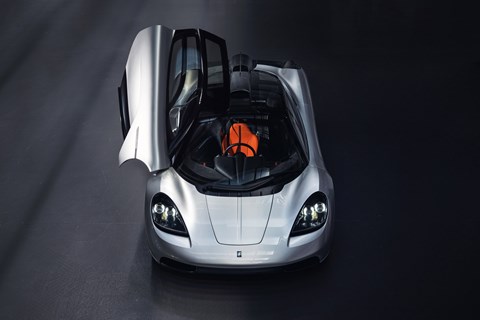
Every area of the T.50 has been subjected to a strict weight-saving programme. Its V12 engine, for example, weighs less than 180kg, making it 60kg leaner than the BMW-derived V12 used in the McLaren F1. This lightness improves responsiveness – GMA claims the engine will rev from idle to its 12,100rpm redline in just 0.3 seconds.
The engine is more than just a high-revving hooligan, though. It’s clever, too. Maximum torque is available at 9,000rpm – and 71% of that will be available from just 2,500rpm, which is unusual for such a highly strung naturally aspirated engine. The engine also has two driving modes. One caps the revs at 9,000rpm (or ‘Ferrari revs’ as Murray calls it) and delivers more low-end grunt, while the other will let the engine scream to its maximum redline.
The V12 is mated to a defiantly old-school six-speed manual gearbox from Xtrac, which is 10kg lighter than the McLaren F1’s gearbox. The weight-savings don’t stop there, though – the T.50’s pedal box is also 300g lighter than the F1’s, while the entire car’s body panels and monocoque weigh in at less than 150kg.
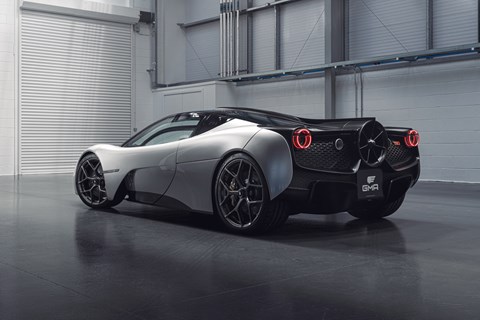
‘Designing a lightweight sports car does not come from specifying exotic materials alone,’ says Murray. ‘It comes from a state of mind, from absolute focus and control, and from a deep understanding of lightweight, optimised design.
‘Today, the enjoyment of driving has been lost as so many supercars only come “alive” at the upper ends of their performance capabilities. Chasing a top speed only adds weight (notably through ever-more powerful engines), so the future of true performance cars lies in shedding weight intelligently.’
Not everything about the T.50 is bespoke, though. The tyres are a set of surprisingly conventional Michelin Pilot Sport 4Ss, measuring 235/35 R19 at the front and 295/30 R20 at the rear. That’s a notably smaller cross section than most supercar makes opt for, but Murray explains that the tyre size was dictated by the weight of the car.
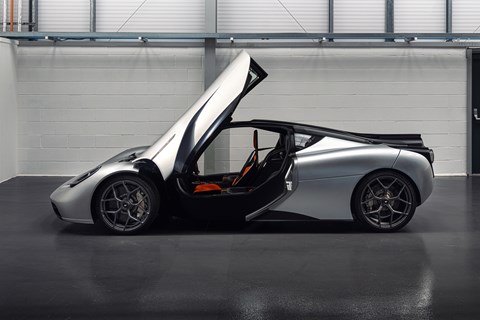
‘We simply don’t need big tyres,’ he said. ‘This car is not about chasing numbers. Most people will put a softer compound on to get a slightly better 0–60mph time. We know this is going to be quick, so it’s better to fit something that is more sensible for everyday use.’
Murray also expressed his frustration at his rival supercar makers. ‘It’s always annoyed me that no one has done an F1 since the F1,’ he said, aware that the sentiment could be construed as a lack of modesty. ‘I know it sounds big-headed, but nobody’s done a pure, lightweight, focused driver’s car since – the T.50 will be better in every way.
‘Given the costs, this could be the last great analogue supercar,’ muses Murray. ‘I’ve driven all the latest supercars. They’re fantastic, but they don’t involve you in any way, shape or form. Get back into an F1 and the hairs on the back of your neck stand up. T.50 will do the same.’
Gordon Murray’s T.50 hypercar: the aero
Yes, it’s daft. At the rear of the T.50, there’s a massive 400mm ground-effect fan powered by a 48v electric motor. The design takes inspiration from the Brabham BT46B fan car car that Murray unleashed on the Formula 1 grid in 1978 and dominated the field until it was banned at the end of the year. By using the underside of the car and the fan to generate the downforce, it negates the need for huge wings at the rear, which makes the lines a lot smoother.
Drivers have six downforce modes to play with – and the different settings also fiddle with a few active aero appendages, like the pair or wings that sit atop the rear diffuser. Auto mode responds to the driver’s inputs, while Braking mode doubles the amount of downforce produced using the fan and deploys the rear aerofoils like an airbrake. This cuts the T.50’s braking distance by 10 metres.
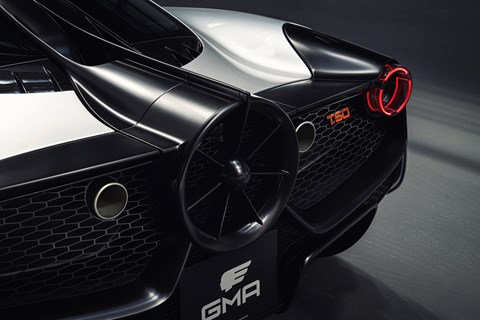
High Downforce mode increases the amount the car is forced onto tarmac by 30%, which is best suited to windy roads. Streamline mode reduces drag by 10% by easing off the downforce which, in turn, increases top speed and reduces fuel consumption. The setting closes all the underbody ducts while the fan increases the trailing wake of the car, creating what Murray calls a ‘virtual longtail.’
Finally, there’s a V-max mode. It works on the same principles as Streamline mode but prioritises top speed over fuel economy and gives the car a 30bhp boost using the 48v electric motor.
Gordon Murray’s T.50 hypercar: interior
The T.50 is unashamedly driver focused. Like the McLaren F1, the driver sits in the middle of the car with a seat behind each of their shoulders. And, while you may not associate hypercars with luggage capacity, the T.50 has 288 litres of space thanks to clever luggage-carrying pods on the car’s sides, a custom-built suitcase for one of the passenger seats and 30 litres-worth of cubby holes.
It’s gorgeous, too. The controls are a masterclass in industrial beauty. The switches, for example, are hewn from aircraft grade titanium, while the brake and clutch pedals are milled from a single block of aluminium – and they have the T.50 badge laser-etched into their faces.
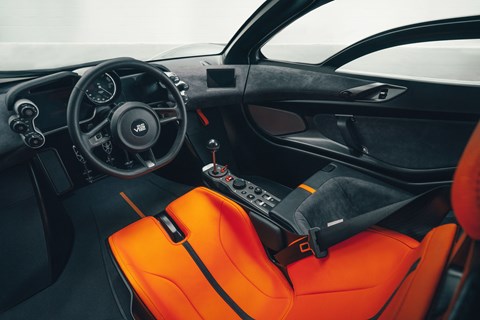
There are two screens either side of an analogue rev counter, both of which are controlled by scroller dials on the otherwise plain steering wheel. GMA has banished control stalks, too, replacing them with thumb buttons on the wheel spokes and paddles for the lights and horn. The idea is that you won’t need to take your hands off the wheel to get other drivers out of your way.
Gordon Murray’s track-only T.50S
But what if you’re a racing driver? The standard T.50 simply won’t be fast enough. That was a problem that rested heavy on GMA’s conscience, so it designed the T.50s Niki Lauda – and unveiled it on the late racing legend’s birthday. It’s lighter, more powerful and, thanks to some wild aero tweaks, even faster in the corners. It’ll set you back £3.1m before taxes, and just 25 will be built.
Think of it as a T.50, in which every little bit is a little bit better. The engine, for example, produces 701bhp (almost 50 more than the standard T.50) – and that can be increased to 725bhp with a RAM induction air box. It features revised cylinder heads and camshafts, a higher compression ratio of 15:1 and a new, free-flowing exhaust system that’s unhindered by road noise regulations. The engine is also just 162kg, or 16kg lighter than the T.50’s.

The carbon fibre monocoque is the same, but the T.50s features revised body panels for better aero. There’s a delta wing arrangement at the rear works, which works with the race-spec front splitter, adjustable dive planes and, of course, the ground-effect fan to produce up to 1,500kg of downforce.
Inside, there’s the same central driving position, but one seat is removed, allowing for a single co-driver if required. Because they’re not required for hammering around a racetrack, the standard car’s air-conditioning system, road car instruments, infotainment, carpets and storage areas have all been stripped out. The T.50s has a Formula One-style rectangular wheel, too.
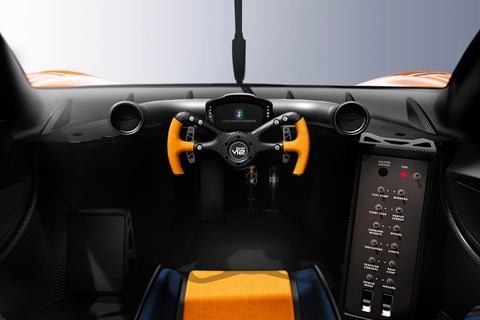
GMA’s intensive weight-saving campaign means the T.50s tips the scales at a bafflingly low 852kg – which means that fancy aero package almost generates twice the car’s weight in downforce.
‘It was essential to me that the T.50s Niki Lauda is easy to live with and enjoy,’ says Gordon Murray. ‘You will own the car; you will be completely in control of where and when you enjoy it. My vision is that owners will take it to a circuit, check the tyre pressures, climb in, fire it up and have fun. That’s the way it should be.’
Production of the T.50s will start after the 100-car production run of the regular T50 ends.
